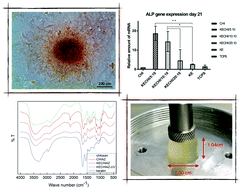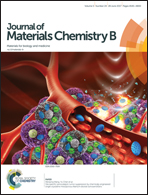Keratin/chitosan UV-crosslinked composites promote the osteogenic differentiation of human adipose derived stem cells†
Abstract
Keratin has intrinsic biocompatibility and contains several peptide-binding motifs that support the attachment of a wide variety of cell types. We have previously shown that keratin extracted from human hair can promote cell adhesion and proliferation of 3T3 fibroblasts, MG63 osteoblasts, and human adipose stem cells (hASCs). Despite its bioactivity advantages, keratin possesses fragile mechanical properties that introduce challenges for tissue engineering. To remedy this, we examined the results of combining keratin with chitosan, a combination facilitated via induction of an azide functional group, which acted as a photocrosslinker, to improve mechanical strength. Analysis of the keratin/chitosan composite showed that films of this material demonstrated good adhesion and promoted the proliferation of human adipose stem cells. Most importantly, this biomaterial was shown to promote the osteogenic differentiation of hASCs, in terms of up-regulations in type I collagen, runt-related transcription factor 2, and alkaline phosphatase gene expression. We further demonstrated that lyophilizing the keratin/chitosan forms highly interconnected and porous scaffolds that might provide an ideal environment for tissue culture. We believe that keratin/chitosan composite biomaterials can be used in bioactive surface modification, and the crosslinkable properties can produce natural polymer 3D scaffolds for the application of tissue engineering research.



 Please wait while we load your content...
Please wait while we load your content...